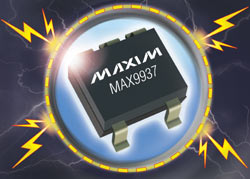Tiny, Automotive-Grade Current-Sense Amplifier Has Reverse-Battery and Load-Dump Protection
Maxim Integrated Products introduces the MAX9937, a tiny, high-side current-sense amplifier that uses external resistors to set the voltage gain for maximum design flexibility
The MAX9937 input common-mode range is 4V to 28V and is independent of the VCC supply voltage, which can operate at 2.7V to 5.5V. When VCC is 5V, the supply current is a low 20µA. When VCC is 0V, the input bias current at the sense resistor is only 1µA to minimize battery drain when the ECU is off.

Voltage gain is set by the ratio of two external resistors to their accuracy. Input offset voltage (VOS) is a low ±1.2mV (max).
The MAX9937 is available in tiny, 3mm x 3mm, 5-pin SC70 package that is lead- and halide-free, thereby RoHS-compliant. This amplifier is fully specified over the -40°C to +125°C automotive temperature range. Prices start at $0.58 (1000-up, FOB USA).
Maxim Integrated Products is a publicly traded company that designs, manufactures, and sells over $2 billion of high-performance semiconductor products annually. It was founded over 25 years ago with the mission to deliver innovative analog and mixed-signal engineering solutions that add value to its customers' products. To date, Maxim has developed over 5800 products serving the industrial, communications, consumer, and computing markets. For more information, go to www.maxim-ic.com.
From: http://www.maxim-ic.com
Publication date: 14.11.2008
Other news ...
- Tektronix Opens U.S. Serial Testing Technology Center
- Fujitsu Providing 65nm RF CMOS Manufacturing Services with Advanced RF CMOS Process Design Kits
- Atmel Launches a New Family of Secure Microcontrollers for Machine-to-Machine Communication Modules
- Atmel's CAP Customizable Microcontroller Hosts JBOSN High-Performance RTOS
- LTC4222: Hot Swap Controller with Onboard Power Monitoring & Fault Logging Protects Dual Supplies
- Intersil Releases Samples of 10A, Highly Integrated Power Module Featuring PWM, Drivers, MOSFETs and Inductor in a Tiny QFN Package
